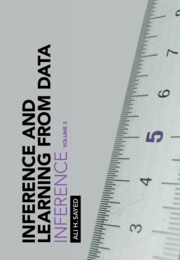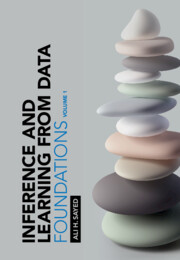Refine search
Actions for selected content:
2327 results in Pattern Recognition and Machine Learning
Preface
-
- Book:
- Introduction to Environmental Data Science
- Published online:
- 23 March 2023
- Print publication:
- 23 March 2023, pp xv-xvii
-
- Chapter
- Export citation
Appendices
-
- Book:
- Introduction to Environmental Data Science
- Published online:
- 23 March 2023
- Print publication:
- 23 March 2023, pp 569-572
-
- Chapter
- Export citation
11 - Time Series
-
- Book:
- Introduction to Environmental Data Science
- Published online:
- 23 March 2023
- Print publication:
- 23 March 2023, pp 372-417
-
- Chapter
- Export citation
3 - Probability Distributions
-
- Book:
- Introduction to Environmental Data Science
- Published online:
- 23 March 2023
- Print publication:
- 23 March 2023, pp 65-100
-
- Chapter
- Export citation
6 - Neural Networks
-
- Book:
- Introduction to Environmental Data Science
- Published online:
- 23 March 2023
- Print publication:
- 23 March 2023, pp 173-215
-
- Chapter
- Export citation
2 - Basics
-
- Book:
- Introduction to Environmental Data Science
- Published online:
- 23 March 2023
- Print publication:
- 23 March 2023, pp 19-64
-
- Chapter
- Export citation
5 - Linear Regression
-
- Book:
- Introduction to Environmental Data Science
- Published online:
- 23 March 2023
- Print publication:
- 23 March 2023, pp 137-172
-
- Chapter
- Export citation
1 - Introduction
-
- Book:
- Introduction to Environmental Data Science
- Published online:
- 23 March 2023
- Print publication:
- 23 March 2023, pp 1-18
-
- Chapter
- Export citation
Notation Used
-
- Book:
- Introduction to Environmental Data Science
- Published online:
- 23 March 2023
- Print publication:
- 23 March 2023, pp xviii-xviii
-
- Chapter
- Export citation
Frontmatter
-
- Book:
- Introduction to Environmental Data Science
- Published online:
- 23 March 2023
- Print publication:
- 23 March 2023, pp i-iv
-
- Chapter
- Export citation
Abbreviations
-
- Book:
- Introduction to Environmental Data Science
- Published online:
- 23 March 2023
- Print publication:
- 23 March 2023, pp xix-xx
-
- Chapter
- Export citation
4 - Statistical Inference
-
- Book:
- Introduction to Environmental Data Science
- Published online:
- 23 March 2023
- Print publication:
- 23 March 2023, pp 101-136
-
- Chapter
- Export citation
Contents
-
- Book:
- Introduction to Environmental Data Science
- Published online:
- 23 March 2023
- Print publication:
- 23 March 2023, pp v-xiv
-
- Chapter
- Export citation

Inference and Learning from Data
- Inference
-
- Published online:
- 17 March 2023
- Print publication:
- 22 December 2022
-
- Textbook
- Export citation

Inference and Learning from Data
- Learning
-
- Published online:
- 24 February 2023
- Print publication:
- 22 December 2022
-
- Textbook
- Export citation

Inference and Learning from Data
- Foundations
-
- Published online:
- 17 February 2023
- Print publication:
- 22 December 2022
-
- Textbook
- Export citation
3 - modeling with gaussian processes
-
- Book:
- Bayesian Optimization
- Published online:
- 25 January 2023
- Print publication:
- 09 February 2023, pp 45-66
-
- Chapter
- Export citation
C - gradients
-
- Book:
- Bayesian Optimization
- Published online:
- 25 January 2023
- Print publication:
- 09 February 2023, pp 307-312
-
- Chapter
- Export citation
11 - extensions and related settings
-
- Book:
- Bayesian Optimization
- Published online:
- 25 January 2023
- Print publication:
- 09 February 2023, pp 245-286
-
- Chapter
- Export citation
1 - Introduction
-
- Book:
- Bayesian Optimization
- Published online:
- 25 January 2023
- Print publication:
- 09 February 2023, pp 1-14
-
- Chapter
- Export citation
